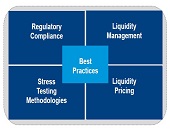“Deal With It”
When it comes to technology advances in the fixed income markets in Canada, “peer-to-peer still needs some work,” said Robert Pemberton, Head of Fixed Income at TD Asset Management. His company’s client base “runs the gamut from retail right through to large investors.” Approximately two and a half million are mutual fund clients. He was the third of three panellists at a September 18, 2015, luncheon sponsored by the CFA Society Toronto, and held at the Toronto Board of Trade. Participants were commenting on regulatory changes in the fixed income markets announced the day before. Canadian Securities Administrators (CSA) will […]
“A Step in the Right Direction”
“The new regulation is a solid step in the right direction,” said Steve Thom, Managing Director at RBC Capital Markets, referring to the September 17 announcement by Canadian Securities Administrators (CSA) on a new reporting system. “The new regulation will increase price transparency, which is important for investors to be able to make more informed decisions. This is a good thing,” said Thom, “but the big thing is size.” He was the second of three panellists at a luncheon, sponsored by the CFA Society Toronto on September 18, 2015, to discuss changes in the fixed income markets. However, “full size transparency would […]
Fairness in Fixed-Income Markets
What are the essential building blocks of market integrity? Information, and fair access to that information. Transparency, but not onerous transparency. “There was a lack of fixed-income data, and large investors had better access to data,” said Ruxandra Smith, Senior Accountant at the Ontario Securities Commission (OSC), the first of three speakers at a luncheon sponsored by the CFA Society Toronto on changes in the fixed income markets in Canada. The event was held at the Toronto Board of Trade on September 18, 2015. Smith was referring to hot-button issues identified in the April 2015 report on the Canadian fixed […]
What is Key to Integrating Op Risk?
“It’s critical to unite multiple perspectives on risk,” said Brenda Boultwood, Senior Vice President at MetricStream, “even though approaches to risk and compliance can be very different” throughout an organization. Boultwood was the second of two speakers at a webinar on operational risk held on August 27, 2015, sponsored by the Global Association of Risk Professionals. A common framework will require standard taxonomies, common definitions, and consistent risk assessment across a company, said Boultwood. She sketched out an integrated enterprise risk management (ERM) framework, in which all types of risk share a common hierarchy, common business processes, and a common […]
Is it OpRisk? or Business Risk?
Operational risk has figured prominently in the business news this summer: a lightning storm destroyed cloud data stored by Google, and a cyber-hack of dating website Ashley Madison breached confidentiality of 33 million accounts. Are companies addressing operational risk the best way possible? What is called operational risk may in fact have its roots in business risk, according to Mike Finlay, Chief Executive of RiskBusiness International. He was the first of two speakers at a webinar on operational risk held on August 27, 2015, sponsored by the Global Association of Risk Professionals. For example, the 2011 Fukushima Daiichi disaster in […]
Conference Call Tones. Part 2
Click here to visit Part 1. Interview with S. McKay Price, continued. Q: In the introduction to your paper on textual analysis of conference call tones, you describe a 2012 conference call in which David Einhorn grilled the management team of Herbalife, thereby causing the shares to fall 20 percent in price. Did you run the transcript of this conference call through your call tone algorithm, and if so, was it the most negative sample in the set? 2012 was not in our sample period so we did not specifically create tone measures for that Herbalife call. Although I suppose […]
Conference Call Tones. Part 1
“Spin,” said Morty. “It’s all about spin.” He pointed to the web interface where he was listening to a certain equipment manufacturing company try to explain anomalies in their reported expenses. Like hyenas, the analysts were picking apart the footnotes. Turning to me, Morty said, “These scoundrels are masters of Orwellian doublespeak,” and then he exited the call. About a year later, I chanced upon research that looks into actual word usage during earnings conference calls. Three authors, Paul Brockman, Xu Li, and S. McKay Price, examined transcripts from nearly three thousand such calls. One of the authors is interviewed […]
“Well Worth The Trouble”
How well positioned are you for the job market in a softening economic environment? Possessing the chartered financial analyst designation, known as the CFA charter, sends a strong signal to potential employers, said Chris Polson, President of the CFA Society Toronto, which is part of the global CFA Institute. He was speaking at the webinar “Capital Markets Compensation Trends” on August 11, 2015, sponsored by CFA Society Toronto. The goals of the webinar were twofold: to recap the value underlying the charterholder designation, and whether this was reflected in the remuneration of Canadian charterholders, as shown by the results of […]
Most Valuable Skill for Risk Managers?
In terms of marketable expertise for financial risk managers, what counts more: quantitative skills, or the ability to communicate and interpret the results of calculations? “The biggest surprise of our in-depth study is that communication ranked above quant skills,” said Christopher Donohue, Managing Director of Research and Educational Programs at the Global Association of Risk Professionals. On June 30, 2015, he reported on the results of the 2015 Job Task Analysis of GARP members. Survey Design The goal of the survey and analysis was to identify knowledge and skills necessary to support competent performance of tasks and responsibilities that are […]
3 Steps to Liquidity Compliance
Are you scrambling to adjust to new reporting expectations for liquidity risk? Getting good data is key, but “you have to get it right and on time,” said Pierre Mesnard, Director Solutions Specialist at Moody’s Analytics. He was the third of three presenters on liquidity risk compliance at a webinar on June 25, 2015, sponsored by the Global Association of Risk Professionals. Once you have the data, there are three steps to delivering integrated liquidity compliance and business management, said Mesnard. First, you must ensure all financial instruments at your bank can be adequately modelled in order to generate realistic […]










